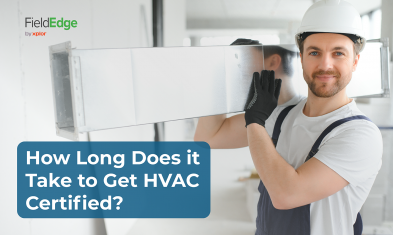By far, one of the most challenging aspects of running your HVAC business is knowing how to price your services. Use this ultimate HVAC pricing guide to help you meet your profit goals and grow a long-lasting business.
While HVAC pricing might seem overwhelming, when you know the right steps to take and factors to think about, you’ll be able to get your HVAC pricing right in no time. Use this complete HVAC pricing guide to help you price your HVAC services based on:
- Profit goals
- Customer feedback
- Your break even point
- Insight from your target market
- Your financial advisor’s advice
- The right pricing model for your business
By the end of this ultimate HVAC pricing guide, you’ll know how to properly price your services. Plus, you’ll get free gifts to download that will help you maximize profit.
1. Gain Insight from Your Local Target Market
To sell your customers on your HVAC pricing, you need to gain insight from your local target market. As a result, you’ll be able to use that gained insight to beat your competition and sell more effectively to customers.
To get started, you need to identify your ideal customer. Think about your favorite customer (or a customer you’d like to win), and answer questions like:
- What’s their age range?
- Are they single or married?
- What’s their education level?
- What’s their household income?
- Do they have kids? If so, how many?
- What are some of their challenges or pain points?
- What do they do for a living? Do they have spare time?
As you answer these questions, it’s important to be as detailed as possible. The more detailed you are, the easier it’ll be to get to know your ideal customer. Then, you can write ads faster and more effectively.
Next, discover what your customers want. The best way to do this is by sending out a survey to your favorite customers. Ask them questions like:
- What about our HVAC business do you love the most?
- Why did you choose our HVAC business over our competitors?
- What do you care most about when choosing an HVAC service provider?
Once you know what your ideal customers want, try to identify any local industry trends. Then, find out which services are the most common. Are there any packages or recurring maintenance services that customers purchase more?
In order to know when to sell, you need to discover local seasonality. What are your busy and slow seasons? Which HVAC services sell best during these times? Use everything you’ve discovered about your ideal customer to leverage what makes your HVAC business stand out from your competition to sell more effectively.
Finally, take advantage of these newfound insights to help you improve your HVAC marketing strategies, and ultimately become more effective in increasing your conversions in your:
Download our FREE Summer HVAC Social Media Posting Guide with 90 social media posts to customize for your business!
2. Find Your Break Even Point
Now that you know how to effectively sell to your customers, you need to find your break even point to determine the minimum amount you need to charge for jobs.
In order to get started, you need to add up all of your monthly overhead costs:
- Utilities
- Software/IT
- Vehicle payments
- Vehicle insurance
- Business insurance
- Property rental costs
- Office staff/leadership pay
- Vehicle/equipment maintenance
Make sure you add up ALL of the costs you incur to complete jobs. Once you’ve added it all up, you’ll have your total monthly business overhead expenses.
Next, you’ll need to find your total estimated labor costs. You can find this by multiplying these numbers together:
- Number of techs on the team
- Average pay
- Hours worked
Then, you need to find your total monthly revenue required (your break even point) by adding both our calculations together:
Total Monthly Business Overhead Expenses + Total Estimated Labor Costs = Total Monthly Revenue Required
Also, don’t forget to share your estimated break even point with your accountant or financial advisor.
Once you add up your costs, you will have determined your break even point! Now, you know the minimum you need to charge in order to avoid losing money on HVAC services.
Did you know that you can easily track all of these costs and more using the best HVAC software for your business? Sign up a FREE demo to explore how FieldEdge can help your HVAC business!
3. Choose Your HVAC Pricing Model (Time and Materials vs. Flat Rate Pricing)
At last, you’ve found your break even point. Now, it’s time to choose your HVAC pricing model to determine how you’ll be charging your customers. As you choose your HVAC pricing model, bear in mind that it might be a factor in your profit goals, calculating costs, and more.
Time and Materials Pricing
In time and materials pricing, the customer is billed for the technician’s time, plus any additional costs incurred while working on the job.
Some HVAC businesses choose the time and materials HVAC pricing model because it helps ensure that your jobs are always profitable. However, keep in mind, time and materials pricing can be harder to sell to customers (especially first-time customers).
Pros of Time and Materials Pricing
- You can set your profit margin for each job, giving you more control over revenue for each job. You don’t have to know exact time and materials averages ahead of time because you can generate the cost after the job.
Cons of Time and Materials Pricing
- It’s harder to sell to customers because they prefer to know the cost up front
- It’s time-consuming because you need to create a new estimate and add up tech’s time and materials for every job.
Flat Rate Pricing
With flat rate pricing, a business combines a technician’s hourly rate with the cost of parts needed. The cost is shown to the customer upfront, so they know what they’re going to pay before labor begins.
While flat rate pricing shouldn’t be intimidating, you need accurate average times and cost of materials. For this reason, you NEED to be using the best HVAC software, FieldEdge.
Pros of Flat Rate Pricing
- Your customers are more at ease because they aren’t hit with any surprise charges.
- You don’t have to go out of your way to create new estimates from scratch – simply refer to a flat rate pricing database tool or book.
Cons of Flat Rate Pricing
- You need to know EXACTLY how much your time and materials cost on average for each job. That’s why a flat rate book or tool is a must!
- Instead of fees being based on your HVAC technician’s time on the job, your technician will have a set amount of time to finish.
The Best HVAC Pricing Model
In order to choose an HVAC pricing model that’s the best of both worlds, we suggest charging service fees in addition to flat rate pricing.
Service Call and Trip Fees
Many HVAC companies charge a trip fee plus a two-hour minimum service fee. If the work exceeds the two hours, you may then move to flat rate pricing, charging only for labor of specific tasks provided. If you follow this model, you might provide a discount for the two hour service call, or waive the fee all together depending on the amount of tasks at hand.
Generally, your trip fee is a set price, but make sure to take your local traffic into account. For example, if you’re in a low-traffic area, then your fee may be lower and vice versa. However, remember that in rural areas without traffic, there is more drive time that needs to be taken into account.
In order to get more first-time HVAC customers, we recommend lowering your service call fee and increasing your labor rates within your flat rate pricing. In turn, you’ll be able to initially attract more customers, while also making the same amount of profit within your flat rate model.
Flat Rate Pricing
It’s important to note that flat rate pricing varies from service to service – not technician to technician. This is because your HVAC pricing should be standardized, and all of your HVAC technicians should be able to complete their jobs within a set timeframe with set tools and equipment. As a result, you won’t charge by the hour.
While flat rate pricing might seem a bit intimidating at first, when you know your numbers and have a set system for equipment and task pricing, you can automatically ensure every job is profitable without spending extra unnecessary time on estimates.
Plus, your customers will be grateful for your upfront approach to HVAC pricing because they know how much you’re going to charge them.
Just make sure that when setting up your flat rate pricing tool or book, you’re factoring a wide variety of equipment costs. The more precise you are in your flat rate pricing, the easier it will be to reach your profit goals!
Automatically and accurately track your time and cost of materials using the #1 HVAC software for your business. Sign up a FREE demo to explore how FieldEdge can help your HVAC business!
4. Calculate Project Costs
In order to determine how much you need to charge for specific projects, you’ll need to calculate your project costs.
First, you’ll need to find your total project material expenses. You can find this by adding these figures together:
- Total cost of parts/equipment per job
- Total cost of chemicals per job
- Disposal costs
Make sure you’ve included all of your specific project costs to this list. Next, you need to determine your total project materials cost by incorporating our previous calculation into this formula:
Total Project Material Expenses + (Total Project Material Expenses x Profit Margin) = Total Project Materials Cost
Now, it’s time to calculate your total labor costs. First, calculate your initial labor costs by multiplying these numbers together:
- Hourly rate
- Estimated number of hours
Next, it’s time to calculate your total project labor costs. Find this by incorporating the previous calculation into this formula:
Total Project Material Cost + Total Project Labor Cost = Total Project Cost
5. Set Achievable Profit Goals
Now, you’re ready to set achievable profit goals that you can incorporate into your pricing for each HVAC service.
Step 1: Calculate Your HVAC Business’ Net Income
In order to set achievable profit goals, you need to know your HVAC business’ net income. You can calculate your HVAC business’ net income by using this formula:
Net Income = Total Revenue – Material Costs – Labor Costs – Overhead Costs
Next, you need to know your profit margin. For this step, simply use the net income you just calculated to help you solve for this formula:
Profit Margin = Net Income / Total Revenue
Step 2: Incorporate Your Profit Margin Goals into the Total Price of the HVAC Service
Now, you need to test out a few different profit margin goals to discover what works best for you. Keep in mind, your sales goal will simultaneously increase with your increased profit margin goals. The main priority here is to keep your profit goals ambitious, yet achievable.
Step 3: Analyze Your Competitors’ HVAC Pricing to Stay Realistic
If you’re pricing your services considerably low or high compared to the majority of your competition, then you might need to consider adjusting your HVAC pricing.
Since your competitors’ costs and goals are different, you can’t copy your competitors’ HVAC pricing. However, it will give you a general idea of whether you’re in the right vicinity.
Once you’ve incorporated your profit goals into your pricing model, you can compare these prices to your competitors to see where you stand.
Pro Tip! In order to help you better determine your prices, be sure to check out this free service agreement calculator.
6. Verify Your New HVAC Pricing With a Trusted Financial Advisor or Accountant
As with ANY major financial decision in your business, it’s absolutely essential that you verify your new HVAC pricing with a trusted financial advisor or accountant prior to finalizing it.
Your financial advisor can tell you how much you need to charge as well as any other factors you might’ve forgotten to consider. Since your finances are vital to the success of your HVAC business, this step is a MUST!
7. Use an HVAC Flat Rate Book
If you plan to follow a flat rate pricing model, use a HVAC price book to provide your potential customers with a detailed explanation of your services and HVAC pricing.
Not only is a book or digital tool useful for helping your customers better understand costs, but it also keeps you from having to answer the same HVAC pricing questions every day. Your HVAC price book should include things like:
- Business name and basic contact information
- Disclaimer that ALL estimates are subject to change
- Breakdown of costs for each task and piece of equipment
Did you know FieldEdge can help you with in-the-field pricebook and invoicing? Rather than using a physical pricebook, you can determine your process for price presentation by going paperless with the best HVAC management software. Book a FREE demo of FieldEdge today!
8. Improve Your HVAC Pricing Process Using Customer Feedback
In order to improve on your HVAC pricing process, you’ll need to listen to customer feedback. Take a look at a few different ways you can gather customer feedback:
- Conduct social media polls
- Call or ask for feedback in-person (after a positive customer experience)
- Text surveys and follow-up texts (easily automate texts using FieldEdge)
- Encourage reviews (keep in mind, you should not incentivize reviews)
- Email surveys and follow-up emails
After you raise your HVAC pricing on a few unprofitable customers, it’s a good time to send out your survey and ask them a few questions to see if they’re still satisfied with your HVAC business.
Once you receive feedback from your customers, adjust your HVAC pricing process for future customers that are more profitable.
Get HVAC customers FAST by downloading our FREE HVAC flyers and door hangers templates now!
Use This Simple HVAC Pricing Guide to Maximize Your Profits
At last, using this simple HVAC pricing guide, you have all the tools and information you need to maximize your profits and conquer your goals.
Now, you know which factors you need to consider as well as how you’ll implement new HVAC pricing.
Use these expert strategies to help you build a long-lasting HVAC business that’s successful for many years to come!
Related: How to Get HVAC Customers FAST





